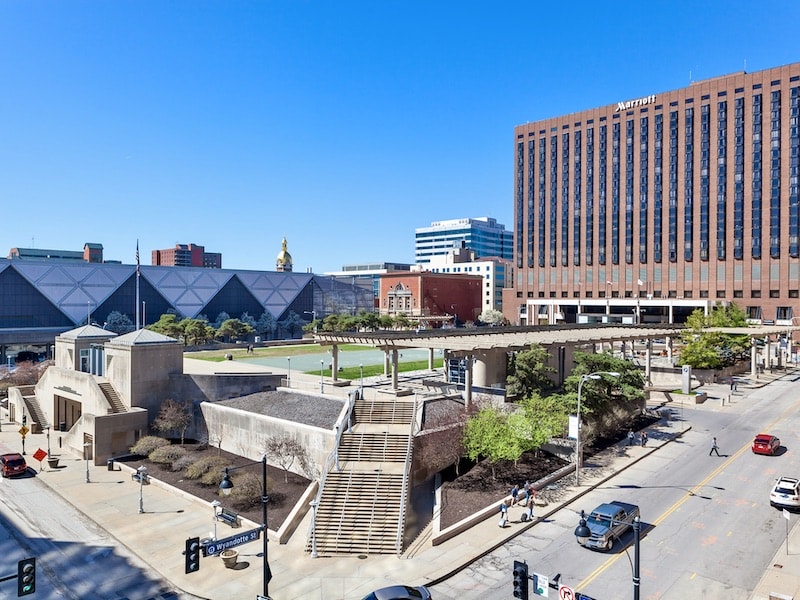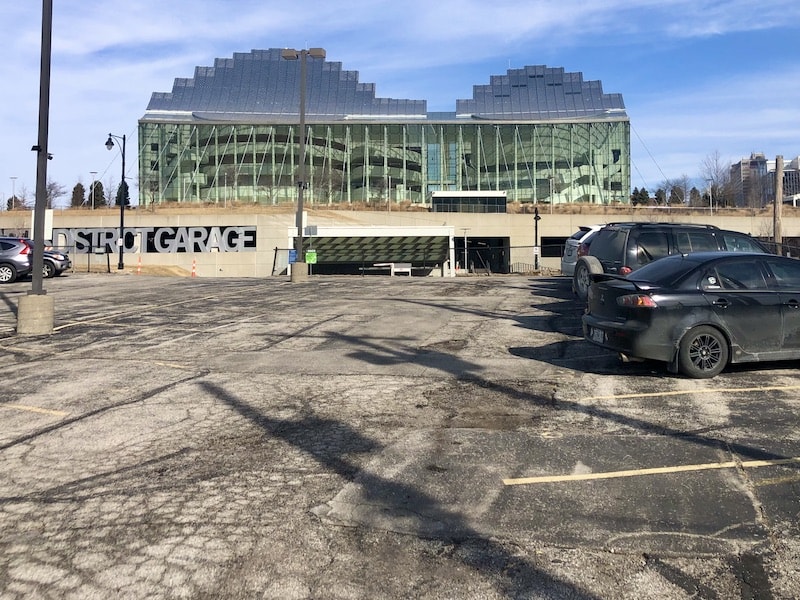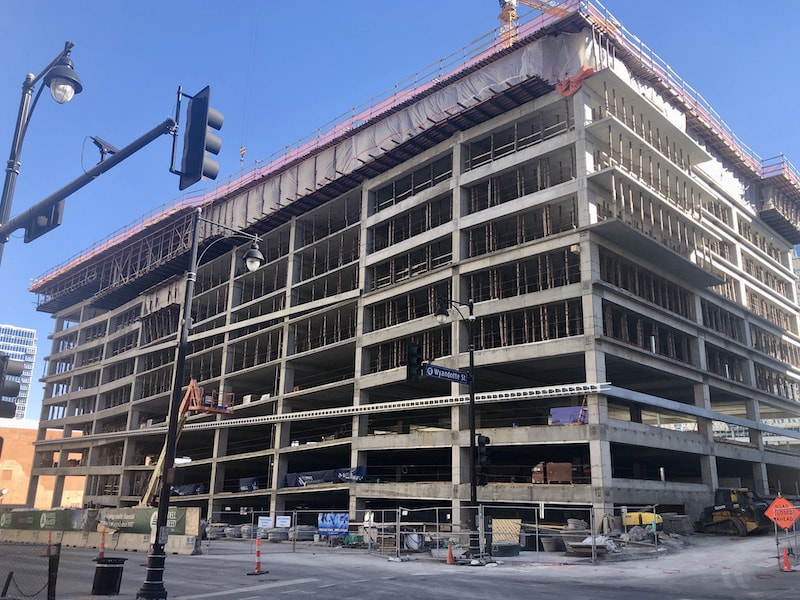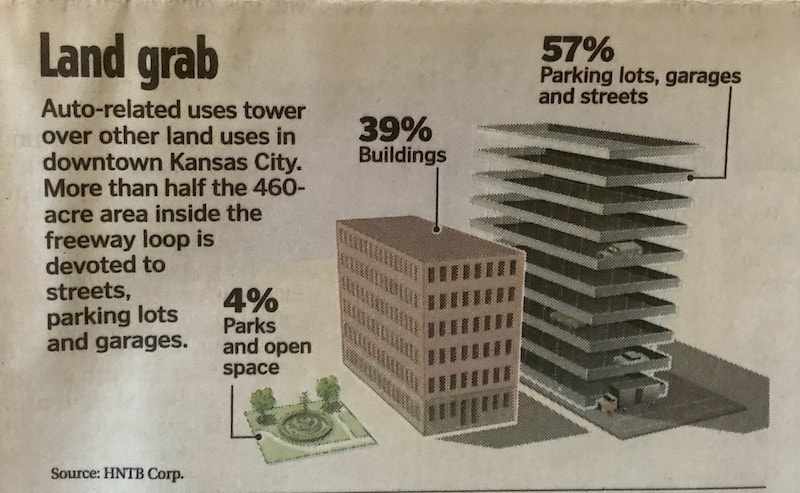Mending Our Broken Heart: Parking, Transit Woes Drive Folks From a Barren Loop (Part 2)

Published October 6th, 2022 at 11:30 AM
“Downtown KC: Mending Our Broken Heart,” was a groundbreaking series originally published by The Kansas City Star 20 years ago this month.
It was written by former staffers Jeffrey Spivak, Kevin Collison and Steve Paul, with photographs by Rich Suggs. It was edited by former deputy national editor Keith Chrostowski.
CityScene KC thanks The Kansas City Star and Mike Fannin, its president and editor, for granting permission to republish this report.
While The Star retained the text of “Mending Our Broken Heart,” the original photos and graphics were unavailable. Photos of that missing material from a reprint of the series were used as much as possible.
The city requires that developers and businesses provide a minimum amount of parking, and often offers tax breaks to help. But it generally stops short of getting into the garage-building business.
Today the city directly owns one downtown garage – the convention center garage under Barney Allis Plaza – and is building a second west of City Hall to serve the government district.
Combined, the two garages account for only 5 percent of the 44,600 parking spots in the downtown loop.
Instead of garages, the city’s generally hands-off approach has encouraged the private sector to create plenty of surface lots.
Indeed, the downtown loop’s vast surface parking lots are a monument to downtown’s convoluted real estate market.
As companies left downtown, often citing a lack of parking, many building owners decided that the most profitable option was to demolish their old buildings and open surface parking lots. Such a move also reduced their property tax bills – and the city’s tax base.
Now nearly a third of the downtown loop’s parking spots are on surface lots that are open wounds in the heart of the city.
Lawyer Robin Threlkeld trudges every day across the cracked asphalt of a parking lot at 14th and Oak streets to the Jackson County prosecutor’s office two blocks away.
She pays $45 a month to park. But her license plate stickers were once pulled off her blue Honda Civic, and she knows of jurors whose cars have been stolen.
Parking lots “are ugly, and I think they’re unsafe,” Threlkeld says. “A parking garage would be more efficient.”

This parking lot across from the Kauffman Center could be replaced with an apartment project in a sweeping redevelopment proposal being pursued by philanthropist Shirley Helzberg.
Despite their sometimes scruffy appearance, Kansas City’s plethora of parking lots means downtown actually stacks up well in terms of the amount of parking compared with its peer cities.
Half of those cities have more than two workers for every parking space in the central business district. In Kansas City, it’s 1.2 workers per space.
That helps explain why downtown’s average monthly parking rates, $66 for unreserved and $76 for reserved, are among the lowest in the country, according to Colliers International.
A recent report by the Economic Development Corp. found that parking is just 80 percent full near the south edge of the downtown freeway loop, the site of some of downtown’s ugliest lots. The industry standard is 90 percent.
Ted Folkert is president of All-City Corp., which owns 20 downtown parking locations with 3,000 spaces and manages two garages.
Asked about the shabby appearance of some downtown lots, he says parking rates are too low:
“The reason they’re not cared for is there hasn’t been the funds.”
Parking’s future
Many believe the city should get more involved in the parking business, especially building garages in strategic locations to encourage development.
Former Mayor Emanuel Cleaver regrets that Kansas City hasn’t done more.
“When you go to the mall or Country Club Plaza, you can park all day for free,” Cleaver says.
“When you add the cost and inconvenience of parking downtown, you erase the limited reasons people have to go downtown.”
Some say the city should duplicate the Plaza’s plentiful parking. But the Plaza’s “free” parking isn’t really free at all.
Much of the cost is passed along through higher prices for shoppers, or, in the case of the new Saks Fifth Avenue garage, a special transportation district funded by a half-cent sales tax on the Plaza.
Tax increment financing, which diverts some sales and other taxes generated by new projects, also is used to help finance Plaza area garages.

The 1400KC office building that just opened at 14th and Baltimore was criticized for some because its first 10 floors are reserved for parking.
It would be great if downtown could provide such “free” parking. But the economics are simply not there – at least not yet.
An extra sales tax isn’t viable because downtown has so little retail. Asking property owners to foot the bill won’t work because they can’t command the Plaza’s higher rents to help finance parking.
“The issue is, how do we develop a plan where we can get downtown demand up so then we can start helping deal with parking,” says Udris of the Economic Development Corp. “We need to develop public parking to help kick-start things.”
That’s where the little-known Kansas City Parking Authority could come in.
The authority was established a few years ago, but it has done little more than discuss policy. The authority has no power to issue bonds, and no revenue to repay them.
The authority’s chairman, developer Jon Copaken, believes it needs to build garages itself or help other public agencies do so. The city also is considering an ordinance to better enforce maintenance standards for surface lots.
“If the city would take an aggressive posture of building new parking to spur development, that would be a welcome thing,” Copaken says.
The Economic Development Corp. has proposed three key locations – among others – for city-assisted downtown garages.
One would be in the Freight House District, to open up the Stuart Hall building and others nearby.

Graphic courtesy The Kansas City Star
The second would be in the River Market, to spur housing and office development there.
The third would serve an office annex planned for the historic Power & Light Building, as well as offer parking for the convention and performing arts district.
The most notable recent stab at financing more parking came when Mayor Kay Barnes pushed for legislation in the Missouri General Assembly. The Missouri Downtown Economic Stimulus Act proposed returning about half of the additional state taxes generated by a new project to subsidize public improvements such as parking. But the proposal hasn’t been approved.
In the meantime, the Economic Development Corp. is asking the City Council to step up the city’s efforts by using so-called super tax increment financing. The plan would use all the city taxes generated by a new development to back a bond issue to build publicly owned garages.
Separately, the council also has put a $35 million bond issue on the November ballot. Part of that money could help finance downtown parking projects.
The benefits would take several forms.
First, more parking in the right spots would make downtown more accommodating for workers and visitors.
Second, more garages could free up surface lots for development, reducing the land area devoted to cars and increasing density and street life.
When it comes to downtown parking, most people agree on one thing: We don’t want parking lots to devour more land. They say the city needs to put more parking garages in key places – which would ultimately help create the density that would support a transit system that connects downtown’s assets.
Even developers who have plenty of lots agree.
“I have 7 or 8 acres of surface lots already,” says Buzz Willard, president of Tower Properties, a big downtown landlord. “I hope it will be replaced by multiuse development.”
THE POLL
As part of the reporting for this series, The Star conducted a poll of area residents to gauge their feelings about downtown. Here are some responses as they relate to parking and transportation. More from the poll can be found at www.kansascity.com. 1. What does downtown need? Free parking?
Yes- 90%
No- 10% 2. Does downtown need to offer free parking after work hours?
Yes- 93%
No- 7% 3. Does downtown need some additional form of mass transit to connect its different parts?
Yes- 72%
No- 28%
When looking at the poll results in total, the margin of error, at a 96 percent confidence level, is plus or minus 4 percentage points. That means that if this study had been repeated under the same circumstances 100 times, the results for each question would not vary by more than 4 percentage points in 96 of the 100 times the study was conducted.


